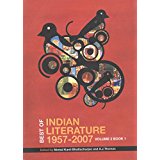The two volumes of Sahitya Akademi’s publication The Best of Indian Literature 1957-2007 is a must have collection for any connoisseur or even someone who is interested in Indian literature of the post-Independence period. This collection in two volumes covers the best of Indian literature written from all corners of India in the first fifty years of Independence. Since all the writings have previously appeared in the Akademi’s journal at some point or the other in the last fifty years, they would be familiar to many readers, who may have read some of the pieces in isolation. The uniqueness of this volume is in a number of things. Firstly, it brings together in a single collection writings from nearly 24 Indian languages in translation. Second, the collection gives an insight into the major literary movements, issues of this period. And third, it brings together, in one collection nearly all the major literary icons of modern India.
September 2013, volume 37, No 9
The two volumes of Sahitya Akademi’s publication The Best of Indian Literature 1957-2007 is a must have collection for any connoisseur or even someone who is interested in Indian literature of the post-Independence period. This collection in two volumes covers the best of Indian literature written from all corners of India in the first fifty years of Independence. Since all the writings have previously appeared in the Akademi’s journal at some point or the other in the last fifty years, they would be familiar to many readers, who may have read some of the pieces in isolation. The uniqueness of this volume is in a number of things. Firstly, it brings together in a single collection writings from nearly 24 Indian languages in translation. Second, the collection gives an insight into the major literary movements, issues of this period. And third, it brings together, in one collection nearly all the major literary icons of modern India.

